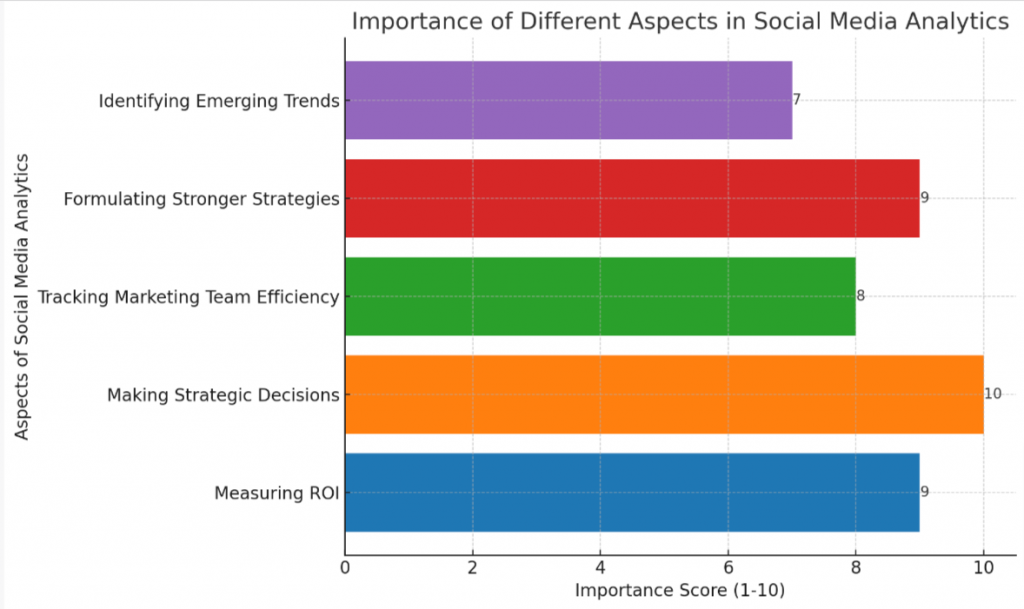Deciphering the Digital Landscape: A Beginner’s Guide to Social Media Analytics
Does your social media activity feel like shouting into a void? That’s where Social Media Analytics comes in. This blog post will unravel how you can tap into this data-driven tool to make informed decisions, boost ROI, and discover new opportunities for brand growth.
Read on – we’re about to turn those likes into insights!
Key Takeaways
- Social media analytics allows businesses to measure ROI, make strategic decisions, and track marketing team efficiency.
- Measuring and proving ROI involves analyzing key performance indicators (KPIs) from various social media platforms.
- Guiding strategic decisions with social media analytics helps businesses formulate stronger strategies and identify emerging trends.
- Tracking marketing team efficiency through social media analytics improves customer experience and satisfaction.
Importance of Social Media Analytics
Social media analytics is crucial for businesses as it helps measure ROI, guides strategic decisions, tracks marketing team efficiency, and allows comparison with competitors.
Measuring and proving ROI
With the use of social media analytics, marketers now have the power to demonstrate a concrete return on investment (ROI). This process involves monitoring and analyzing key performance indicators (KPIs) from various marketing campaigns deployed across platforms such as Facebook, LinkedIn, Twitter, and Instagram.
By carefully assessing metrics like click-through rates, link clicks, audience demographics – just to name a few – organizations can quantify their social media success. Analytics tools further enhance this process by offering real-time data about ad spending and campaign performance that paints a clear picture of cost versus benefit.
Therefore, measuring and proving ROI is an indispensable step in revealing the true value produced by a brand’s social media efforts.
Guiding strategic and business decisions
Social media analytics serve as an indispensable tool often employed by companies to guide their strategic and business decisions. Leveraging insights from the course “Introduction to Social Media Analytics” can equip businesses with a powerful aid in driving critical decision-making processes.
This can translate into formulating stronger strategies, identifying and capitalizing on emerging trends, tracking marketing team efficiency, and providing a comparative analysis against rivals.
Powerful social media metrics play a pivotal role in corporate entrepreneurship which goes beyond merely generating reports or charts. These robust data points shed light on consumer perceptions, interests and behaviors among several other aspects of customer profiles – all crucial for guiding strategic business decisions.
Furthermore, tools like Sprout Social or Buffer Analyze enable firms to make more informed decisions based on real-time consumer sentiment analysis using machine learning algorithms.
Tracking marketing teams’ efficiency
Efficient marketing teams leverage benefits from social media analytics in multiple ways. They employ strategies that are data-driven, using insights derived from audience demographics, user behavior and engagement levels across different platforms such as Facebook, Instagram, LinkedIn and Twitter.
Social media analytics can give them a clear picture of how well their campaigns are performing by showing real-time data on key performance indicators (KPIs) like click-through rates and link clicks.
They use this information to optimize ad spending and maximize return on investment (ROI). Moreover, these metrics also allow teams to monitor response time and customer sentiment towards their brand which can help improve customer experience and satisfaction.
Comparing social media performance against competitors
Keeping a close eye on your competitors’ social media activities offers measurable benefits. Assessing their posting frequency, content quality, and audience engagement can provide useful learnings for your own strategies.
Tools such as Sprout Social or Buffer Analyze can help you track these metrics richly. For instance, Delta Air Lines skilfully used Emplifi’s social media analytics to not only understand their digital audiences better but also save an impressive $2 million in support and operations costs.
Regular competitor comparison is essential to gain insights that could lead to improved social media performance and increased return on investment for businesses.
What Does Social Media Analytics Entail?
Social Media Analytics entails a wide range of metrics and analyses, including audience analytics, social media performance analytics, competitive analytics, paid social media analytics, customer service and community management analytics, influencer performance analytics, and sentiment analysis.
Curious to learn more about how each of these components can help your business? Keep reading!
Audience analytics
The course “Introduction to Social Media Analytics” offers a comprehensive exploration of audience analytics. Taught by expert David Schweidel, this course delves into the crucial aspect of understanding your social media audience.
With approximately 9 hours of content and over 22,000 enrollments, it is clear that there is a high demand for learning about audience analytics. By studying this topic, learners gain valuable insights into their audience’s demographics, interests, and behaviors, allowing them to make informed decisions when creating content and developing marketing strategies.
Social media performance analytics
Social media performance analytics allows businesses to track the effectiveness of their social media campaigns in real-time. By analyzing metrics such as the number of followers, interactions across platforms, click-through rate, and link clicks, organizations can gauge how well their content is resonating with their target audience.
This data helps companies understand which messaging and topics are most successful and make informed decisions to improve their social media performance. Additionally, social media performance analytics provides insights into the efficiency of marketing teams by measuring response time and customer sentiment.
By identifying areas for improvement and automating workflows where possible, businesses can optimize their social media strategies and enhance overall performance.
Competitive analytics
Competitive analytics is a crucial aspect of social media analytics that involves analyzing the performance of various social media platforms, such as Facebook, LinkedIn, and Twitter.
This type of analysis helps organizations compare their social media performance against competitors in order to gain insights into effective strategies and identify areas where improvements are needed.
By examining metrics like the number of followers, click-through rate, and total interactions per 1,000 followers for different platforms, businesses can make data-driven decisions to stay ahead in the competitive landscape.
Paid social media analytics
Paid social media analytics involves collecting and analyzing data from social media platforms that businesses have paid to advertise on. It provides valuable insights into the performance and effectiveness of paid social media campaigns.
Marketers can determine the return on investment (ROI) and the success of their advertising efforts through analyzing data from paid social media campaigns. They can also identify which platforms and messages resonate best with their target audience.
Popular social media platforms used for paid advertising include Facebook, LinkedIn, Twitter, and Instagram.
Customer service and community management analytics
Social media analytics plays a crucial role in customer service and community management. By analyzing data from social platforms such as Facebook, LinkedIn, Twitter, and Instagram, businesses can gain valuable insights into audience demographics, interests, behaviors, and sentiment.
This information allows them to deliver excellent communication and support to their customers. Furthermore, social media analytics tracks the efficiency of marketing teams by measuring response time and identifying areas for automation.
Tools like Sprout Social provide in-depth metrics that help businesses improve customer service performance and enhance community engagement.
Audience analytics from social media are essential for understanding customer behavior and preferences. By harnessing this data, companies can predict customer needs and tailor their services accordingly.
Additionally, social media analytics enables businesses to monitor brand perception in real-time, identify emerging trends, and optimize their social media content strategy. With AI-enabled tools becoming more sophisticated each day, there are endless possibilities for using social media analytics to build stronger relationships with customers while driving business growth.
Influencer performance analytics
Emplifi offers analytics solutions, including influencer performance analytics, to help businesses assess the effectiveness of their influencer marketing campaigns. With Emplifi’s service analytics, brands and agencies can track the total interactions per 1,000 followers, audience size, most frequently used hashtags, and number of posts created by influencers.
By analyzing these metrics, businesses can gain insights into the impact and reach of their influencer partnerships. Emplifi’s expertise in providing effective analytics solutions for global brands and agencies highlights the usefulness of its influencer performance analysis capabilities.
Sentiment analysis
Sentiment analysis is a crucial aspect of social media analytics. It enables businesses to monitor and analyze online mentions in real-time, helping them identify any sudden spikes in negative sentiment towards their brand or products.
By tracking sentiment, businesses can take immediate action to address any issues or concerns raised by customers on social media platforms. Moreover, sentiment analysis provides valuable insights into audience behavior and consumer perceptions, allowing companies to gauge the effectiveness of their marketing strategies and campaigns.
Overall, sentiment analysis plays a vital role in helping businesses stay informed about how they are perceived online and make data-driven decisions to improve customer satisfaction.
Understanding Social Media Analytics vs Social Media Data
Social media analytics and social media data are two terms often used interchangeably, but they have distinct differences. Social media data refers to the raw information gathered from various social platforms, such as Facebook, LinkedIn, Twitter, and Instagram.
It includes metrics like the number of followers, click-through rate, link clicks, and audience demographics. On the other hand, social media analytics involves analyzing this data to gain actionable insights.
While social media data provides valuable information about a brand’s online presence and performance metrics, social media analytics takes it a step further by extracting meaning from that data.
With social media analytics tools like Sprout Social or Buffer Analyze powered by AI technology and machine learning algorithms, marketers can examine patterns in user interactions across platforms and predict customer behavior.
By using sentiment analysis techniques on customer conversations happening on social networks with tools like Qualtrics XM platform for experience management or leveraging survey data analysis capabilities offered by companies specializing in market research such as Crimson Hexagon brands can gain deeper insights into their customers’ experiences and perceptions.
Understanding the difference between social media analytics vs. social media data is crucial for businesses aiming to improve their marketing campaigns effectively. While raw data gives you an overview of your brand’s performance on different platforms at any given time; utilizing analytical tools helps marketers make informed decisions based on trends emerging among consumers around the world which assists in benchmarking against competitors’ strategies too.
Key Metrics to Track in Social Media Analytics
Measuring the success of your social media efforts requires tracking key metrics. Here are some important metrics to track in social media analytics:
- Engagement Rate: Measure how often your audience interacts with your content through likes, comments, and shares.
- Reach: Determine how many unique users see your posts or content.
- Click-Through Rate (CTR): Track the percentage of users who click on a link or call-to-action within your social media posts.
- Conversion Rate: Measure the percentage of users who take a desired action, such as making a purchase or signing up for a newsletter, after clicking on your social media links.
- Sentiment Analysis: Analyze the overall sentiment of user comments and interactions to understand how customers perceive your brand.
- Follower Growth: Keep track of the number of new followers you gain over time to gauge the effectiveness of your content and outreach strategies.
- Customer Lifetime Value (CLTV): Calculate the predicted revenue generated by a customer throughout their relationship with your brand, which can help you evaluate the value of acquiring new customers versus retaining existing ones.
How to Implement Social Media Analytics
Implementing social media analytics involves gathering relevant statistics, setting benchmarks, generating comprehensive reports, identifying trends and customer behavior patterns, and taking strategic action to improve social media performance.
Gathering social media statistics
To effectively analyze social media performance, it is crucial to gather accurate and comprehensive statistics. This includes collecting data on various metrics such as audience demographics, engagement levels, click-through rates, and the number of followers across different platforms like Facebook, LinkedIn, Twitter, and Instagram.
By collecting these statistics using tools like Sprout Social or Buffer Analyze, marketers can gain valuable insights into their audience’s preferences and behaviors. These statistics enable businesses to track the success of their marketing campaigns, identify emerging trends in customer behavior, and make informed decisions to improve their social media performance.
With data-driven analytics at their fingertips, companies can optimize their content strategies and engage with customers more effectively.
Setting benchmarks
Setting benchmarks is a crucial step in implementing social media analytics. By establishing specific targets or standards, businesses can measure their social media performance and track progress over time.
These benchmarks can be based on various metrics, such as the number of followers, engagement rate, click-through rate, or customer sentiment. When setting benchmarks, it’s important to consider industry standards and competitors’ performance to gain insights into areas for improvement.
With clear benchmarks in place, businesses can analyze their social media data more effectively and take informed actions to enhance their overall social media presence. The course “Introduction to Social Media Analytics” offered by Coursera provides valuable guidance on how to set meaningful benchmarks in this dynamic digital landscape.
Generating social media analytics reports
Generating social media analytics reports is a crucial step in implementing social media analytics. These reports provide valuable insights into the performance of your social media campaigns and help you make informed decisions to improve your strategy.
By analyzing data such as engagement, reach, and conversion rates, you can identify trends, understand customer behavior, and measure the impact of your marketing efforts. With tools like Sprout Social and Buffer Analyze, you can easily gather data from different platforms and generate comprehensive reports that highlight key metrics and trends.
This enables you to track the effectiveness of your social media activities and make data-driven decisions to optimize your campaigns for better results.
Identifying trends and customer behavior
Social media analytics is a powerful tool for identifying trends and understanding customer behavior. By analyzing data from social media platforms, businesses can gain valuable insights into what their customers want, how they interact with content, and what influences their purchasing decisions.
This allows companies to tailor their marketing strategies to better meet customer needs and preferences. With the help of social media analytics tools, businesses can track engagement metrics, monitor sentiment analysis, identify emerging trends, and even predict customer behavior.
By staying ahead of the curve and understanding their target audience on a deeper level, companies can make informed decisions that drive success in the ever-changing landscape of social media.
Taking action to improve social media performance
Improving social media performance requires proactive steps to optimize your online presence. Start by analyzing the data and metrics provided by social media analytics tools. Look for key insights on audience demographics, engagement rates, and content effectiveness.
Use this information to identify areas of improvement and set realistic goals. Experiment with different strategies, such as using targeted ads or optimizing your posting schedule.
Regularly monitor your progress and make adjustments based on the results. By taking action to improve social media performance, you can increase brand awareness, reach a larger audience, and drive better business outcomes.

Choosing the Right Social Media Analytics Tool
Effort scoring, sentiment analysis, and emotion analysis are important features to consider when choosing a social media analytics tool. The tool should be able to segment data and analyze customer sentiment and interactions across different platforms.
It should also be able to pull in relevant data from various sources, such as web analytics and operational metrics. Overlaying information across different business areas can provide a deeper understanding of the target audience.
Benchmarking is important for evaluating social media performance and comparing it to competitors.
Conclusion
In conclusion, understanding social media analytics is crucial for measuring ROI, guiding strategic decisions, and tracking marketing team efficiency. By implementing the right tools and analyzing key metrics, businesses can gain valuable insights into audience behavior and improve their social media performance.
With the increasing importance of social platforms in today’s digital landscape, mastering social media analytics is essential for staying competitive in the market.

